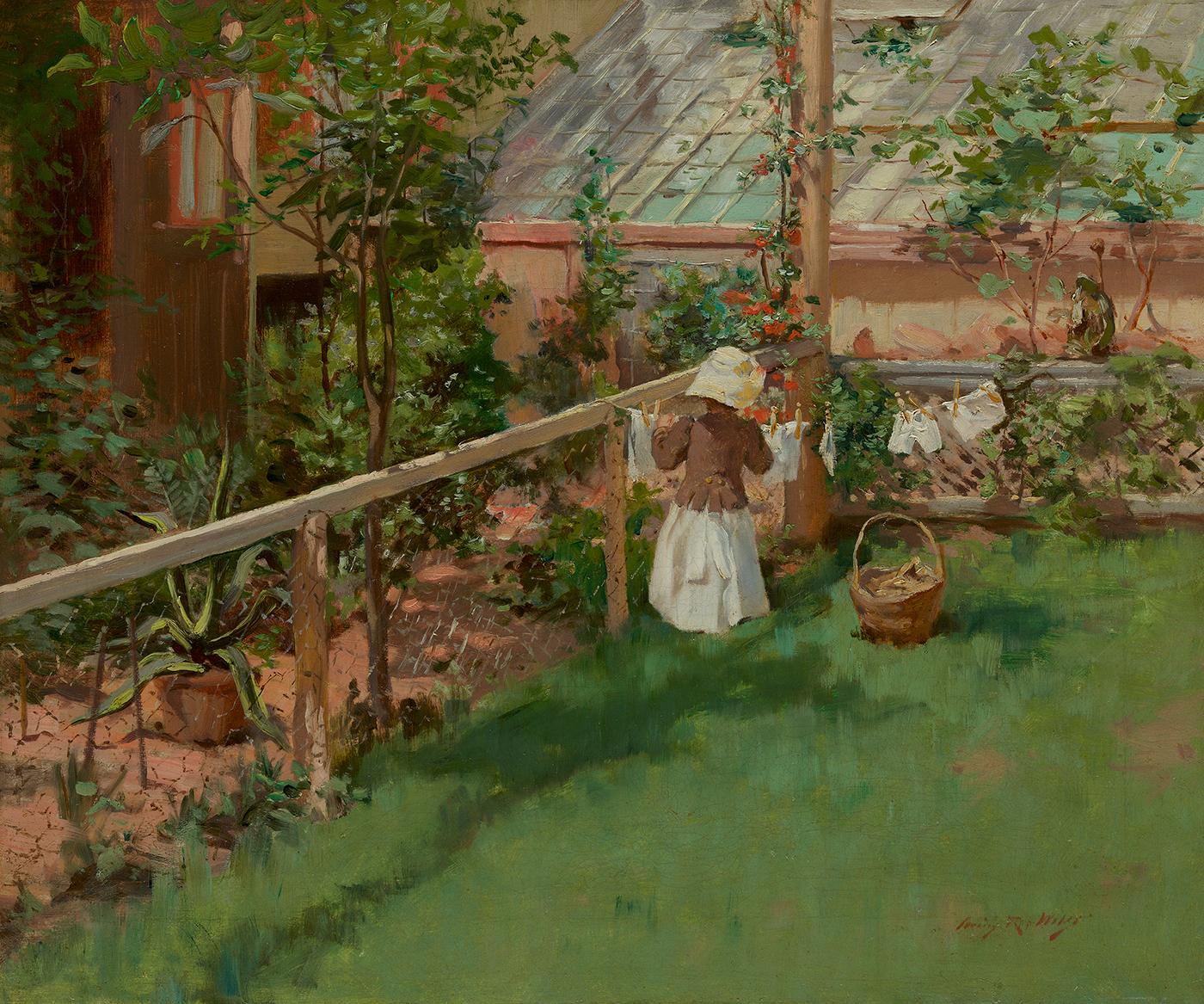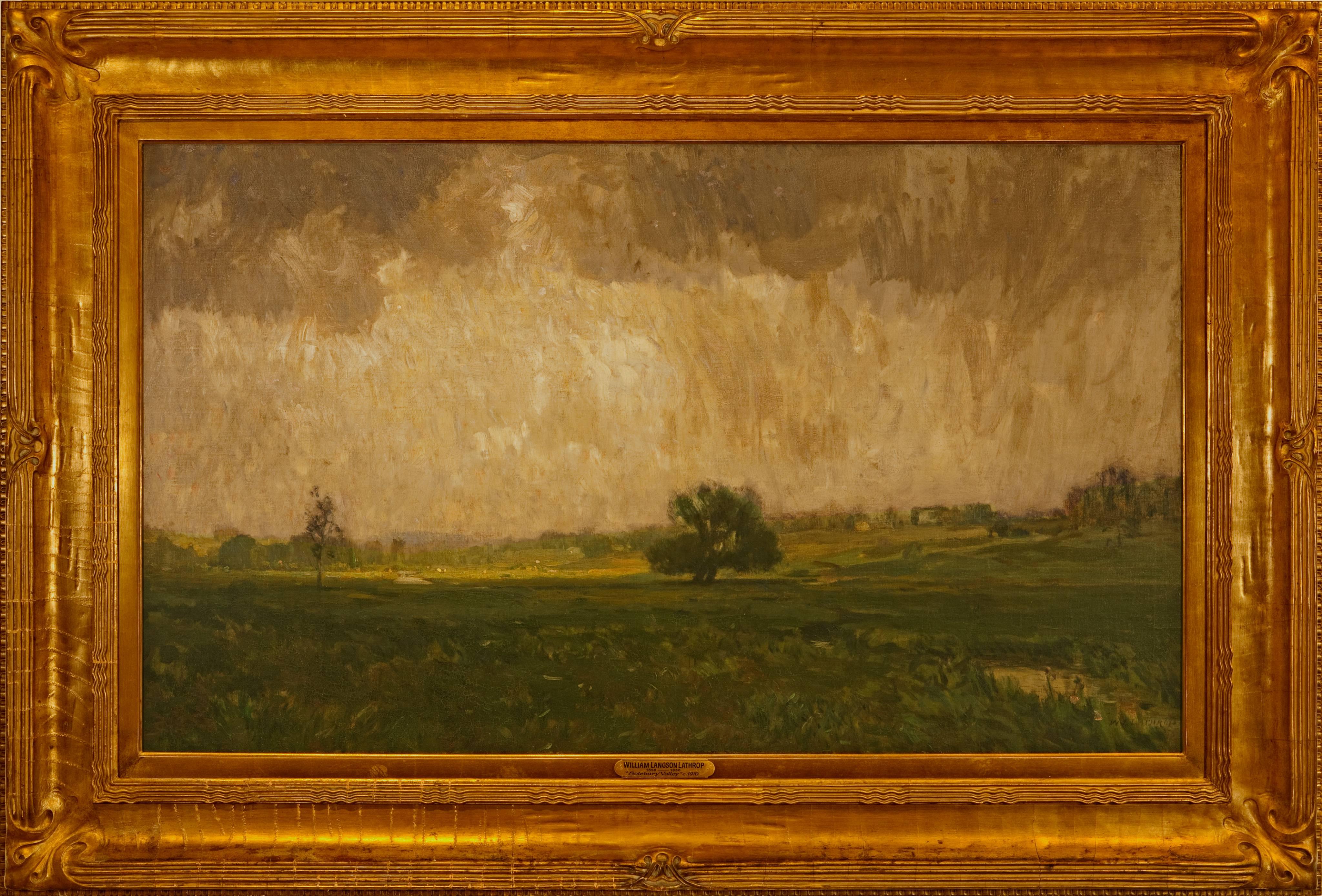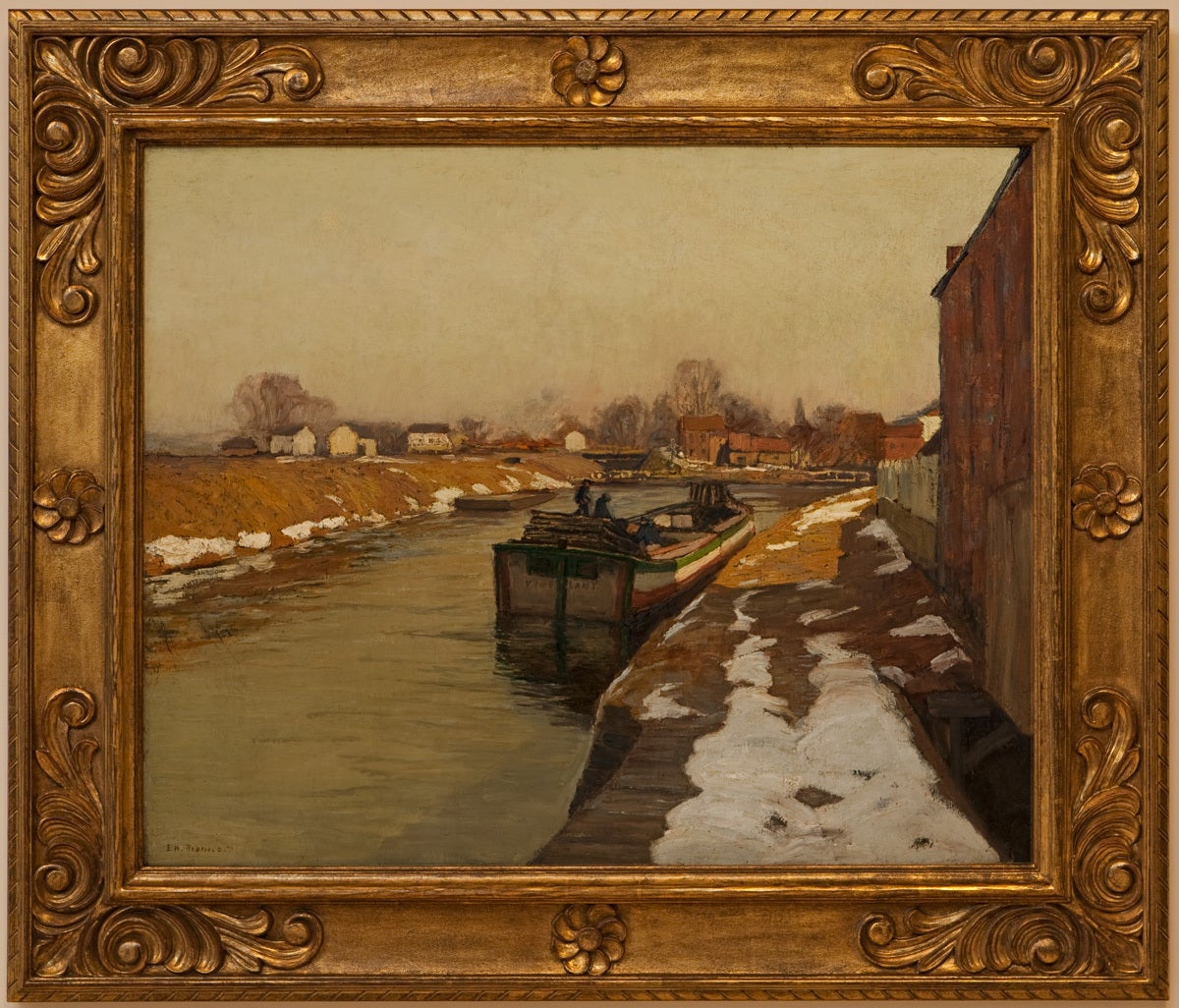Want more images or videos?
Request additional images or videos from the seller
1 of 11
Charles Edwin Lewis GreenParker River, Milton, NH
About the Item
This nice impressionist landscape of a New Hampshire river was painted by American artist Charles Edwin Lewis Green (1844-1915). Green was born in Lynn, Massachusetts and became a regular exhibitor at the Boston Art Club and also took lessons there. In 1885, he moved to Boston where he and his close friend and artist Charles Woodbury committed themselves to making a living exclusively with fine art. They succeeded, and for several years, they were linked together as being non-European trained, stay-at-home artists with very similar impressionist styles and American subject matter. He was part of the seven “Lynn Beach Painters,” along with his friend, Charles Woodbury.
Oil on canvas, signed lower right, title inscribed on verso stretcher “Parker River, Milton, NH,” and housed in a molded giltwood frame. Dimensions: 10 in h x 14 in w, actual; 14 in h x 18 in w, framed.
- Creator:Charles Edwin Lewis Green (1844-1915, American)
- Dimensions:Height: 14 in (35.56 cm)Width: 18 in (45.72 cm)Depth: 0.75 in (1.91 cm)
- Medium:
- Movement & Style:
- Period:
- Condition:Good to excellent overall condition, with minor imperfections. Please contact us directly for a complete condition report before purchasing.
- Gallery Location:Milford, NH
- Reference Number:
Charles Edwin Lewis Green
Charles Edwin Lewis Green was born in Lynn, Massachusetts, in 1844. He became a regular exhibitor at the Boston Art Club and also took lessons there. In 1885, he moved to Boston, where he and his close friend and artist Charles Woodbury committed themselves to make a living exclusively with fine art. They succeeded and for several years, they were linked together as being non-European trained, stay-at-home artists with very similar impressionist styles and American subject matter. Green was part of the seven Lynn Beach Painters, along with his friend, Charles Woodbury.
About the Seller
5.0
Gold Seller
These expertly vetted sellers are highly rated and consistently exceed customer expectations.
Established in 1983
1stDibs seller since 2018
75 sales on 1stDibs
Typical response time: 1 hour
- ShippingRetrieving quote...Ships From: Milford, NH
- Return PolicyA return for this item may be initiated within 1 day of delivery.
More From This SellerView All
- On The FenceBy John Rutherford BoydLocated in Milford, NHA fine impressionist oil painting of a woman sitting near a fence by American artist John Rutherford Boyd (1884-1951). Boyd was born in Philadelphia, PA, and attended the Pennsylvania Academy of Fine Arts, where he studied under American painter Thomas Anshutz...Category
Early 1900s American Impressionist Figurative Paintings
MaterialsCanvas, Oil
- Seated Woman In WhiteBy John Rutherford BoydLocated in Milford, NHA fine impressionist oil painting of a beachside scene with figures by American artist John Rutherford Boyd (1884-1951). Boyd was born in Philadelphia, PA, and attended the Pennsylvania Academy of Fine Arts, where he studied under American painter Thomas Anshutz...Category
Early 20th Century American Impressionist Figurative Paintings
MaterialsCanvas, Oil
- Golf Course, Probably The Country Club, Brookline MABy Arthur Clifton GoodwinLocated in Milford, NHA fine landscape of a golf course, probably The Country Club, Brookline, MA by American artist Arthur Clifton Goodwin (1864-1929). Born in Portsmouth, New Hampshire, Goodwin lived an...Category
Early 20th Century American Impressionist Landscape Paintings
MaterialsCanvas, Oil
- Pair of BirdsBy Abbott Handerson ThayerLocated in Milford, NHA fine woodland scene oil painting with two birds by American artist Abbott Handerson Thayer (1849-1921). Thayer was born in Boston to a prominent family and attended the Chauncey Hall School, founded by his grandfather. His art teacher there was Henry Morse from whom he learned to do animal portraits. He studied at the Brooklyn Academy of Design with Lemuel Wilmarth, and after marrying Kate Bloede, he went to Paris for a year, as a student of Jean Leon Gerome. In 1879, he opened a studio in Brooklyn in the same building as the studios of Thomas Dewing...Category
Late 19th Century American Impressionist Animal Paintings
MaterialsCanvas, Oil
- On The Dunes Near ProvincetownBy Nellie Augusta KnopfLocated in Milford, NHA fine impressionist landscape oil painting by American artist Nellie Augusta Knopf (1875-1962). Knopf was born in Chicago, IL, and studied art at the Art Institute of Chicago where she studied under John Vanderpoel and Frederick Free...Category
Early 20th Century American Impressionist Landscape Paintings
MaterialsCanvas, Oil
- Salmon FishingBy John WhorfLocated in Milford, NHA fine impressionist sporting painting with salmon fisherman in a canoe by American artist John Whorf (1903-1959). Whorf was born in Winthrop, Massachusetts and by the age of sixteen...Category
Mid-20th Century American Impressionist Landscape Paintings
MaterialsOil, Canvas
You May Also Like
- At the ClotheslineBy Irving Ramsey WilesLocated in New York, NYSigned lower right: Irving R. WilesCategory
Late 19th Century American Impressionist Landscape Paintings
MaterialsCanvas, Oil
- "Alley Fiends"By John R. GrabachLocated in Lambertville, NJJim’s of Lambertville is proud to offer this artwork by: John R. Grabach (1886 - 1981) John Grabach was a highly regarded New Jersey artist, teacher, and author of the classic text...Category
1930s American Impressionist Landscape Paintings
MaterialsCanvas, Oil
- "Forest Strongholds"By John F. CarlsonLocated in Lambertville, NJSigned lower right. Complemented by a hand carved and gilt frame. Exhibited at the National Academy of Design, 1928Category
20th Century American Impressionist Landscape Paintings
MaterialsCanvas, Oil
- "Solebury Valley"By William Langson LathropLocated in Lambertville, NJSigned lower right. Complemented by a period frame. William L. Lathrop (1859-1938) Deemed “Father of the New Hope Art Colony”, William Langson Lathrop was born in Warren, Illinois. He was largely self-taught, having only studied briefly with William Merritt Chase in 1887, at the Art Students League. Lathrop first moved east in the early 1880s, and took a job at the Photoengraving Company in New York City. While there, he befriended a fellow employee, Henry B. Snell. The two men became lifelong friends and ultimately, both would be considered central figures among the New Hope Art Colony. Lathrop's early years as an artist were ones of continuing struggle. His efforts to break through in the New York art scene seemed futile, so he scraped enough money together to travel to Europe with Henry Snell in1888. There he met and married an English girl, Annie Burt. Upon returning to New York, he tried his hand at etching, making tools from old saw blades...Category
1910s American Impressionist Landscape Paintings
MaterialsCanvas, Oil
- Winter MoonlightBy George William SotterLocated in Lambertville, NJsigned lower rightCategory
1910s American Impressionist Landscape Paintings
MaterialsCanvas, Oil
- "The Canal"By Edward Willis RedfieldLocated in Lambertville, NJJim’s of Lambertville is proud to offer this artwork. Signed lower left. Complemented by a hand carved and gilt frame. Illustrated in "Edward Redfield: Just Values and Fine Seeing" by Constance Kimmerle and the Pennsylvania Academy of the Fine Arts's Exhibition of Paintings by Edward Redfield (April 17 to May 16, 1909) brochure Edward Willis Redfield (1869 - 1965) Edward W. Redfield was born in Bridgeville, Delaware, moving to Philadelphia as a young child. Determined to be an artist from an early age, he studied at the Spring Garden Institute and the Franklin Institute before entering the Pennsylvania Academy from 1887 to 1889, where he studied under Thomas Anshutz, James Kelly, and Thomas Hovenden. Along with his friend and fellow artist, Robert Henri, he traveled abroad in 1889 and studied at the Academie Julian in Paris under William Bouguereau and Tony Robert-Fleury. While in France, Redfield met Elise Deligant, the daughter of an innkeeper, and married in London in 1893. Upon his return to the United States, Redfield and his wife settled in Glenside, Pennsylvania. He remained there until 1898, at which time he moved his family to Center Bridge, a town several miles north of New Hope along the Delaware River. Redfield painted prolifically in the 1890s but it was not until the beginning of the twentieth century that he would develop the bold impressionist style that defined his career. As Redfield’s international reputation spread, many young artists gravitated to New Hope as he was a great inspiration and an iconic role model. Edward Redfield remained in Center Bridge throughout his long life, fathering his six children there. Around 1905 and 1906, Redfield’s style was coming into its own, employing thick vigorous brush strokes tightly woven and layered with a multitude of colors. These large plein-air canvases define the essence of Pennsylvania Impressionism. By 1907, Redfield had perfected his craft and, from this point forward, was creating some of his finest work. Redfield would once again return to France where he painted a small but important body of work between 1907 and 1908. While there, he received an Honorable Mention from the Paris Salon for one of these canvases. In 1910 he was awarded a Gold Medal at the prestigious Buenos Aires Exposition and at the Panama-Pacific Exposition of 1915 in San Francisco, an entire gallery was dedicated for twenty-one of his paintings. Since Redfield painted for Exhibition with the intent to win medals, his best effort often went into his larger paintings. Although he also painted many fine smaller pictures, virtually all of his works were of major award-winning canvas sizes of 38x50 or 50x56 inches. If one were to assign a period of Redfield’s work that was representative of his “best period”, it would have to be from 1907 to 1925. Although he was capable of creating masterpieces though the late 1940s, his style fully matured by 1907 and most work from then through the early twenties was of consistently high quality. In the later 1920s and through the 1930s and 1940s, he was like most other great artists, creating some paintings that were superb examples and others that were of more ordinary quality. Redfield earned an international reputation at a young age, known for accurately recording nature with his canvases and painting virtually all of his work outdoors; Redfield was one of a rare breed. He was regarded as the pioneer of impressionist winter landscape painting in America, having few if any equals. Redfield spent summers in Maine, first at Boothbay Harbor and beginning in the 1920s, on Monhegan Island. There he painted colorful marine and coastal scenes as well as the island’s landscape and fishing shacks. He remained active painting and making Windsor style furniture...Category
Early 1900s American Impressionist Landscape Paintings
MaterialsCanvas, Oil






